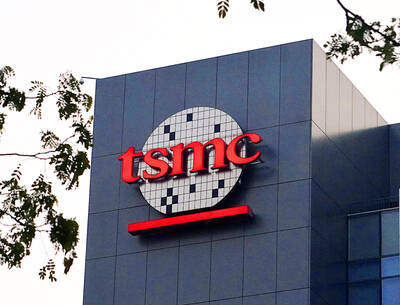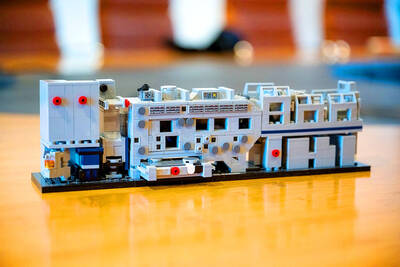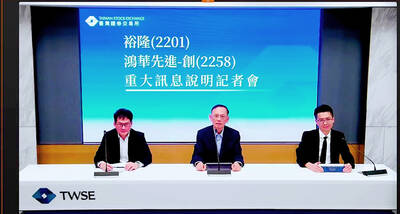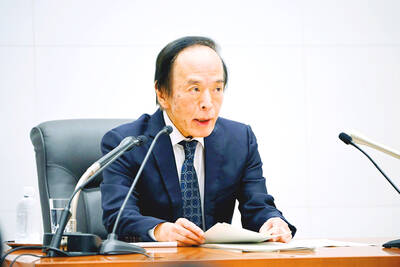The business climate monitor for presale residential projects and new houses in northern Taiwan last month turned “yellow-red,” the first signal indicating a boom in 16 years, My Housing Monthly (住展雜誌) said yesterday.
The total score of constituent measures stood at 52.6, rising from 45.1 in February and ending 15 consecutive months of “green” signals, which suggests steady growth, My Housing Monthly spokesman Chen Ping-chen (陳炳辰) said.
The impressive showing came after developers released NT$100 billion (US$3.09 billion) of presale projects in northern Taiwan to take advantage of the spring sales season, which started late last month and runs until the end of this month, Chen said.

Photo: Hsu Yi-ping, Taipei Times
Projects in New Taipei City’s Tamsui District (淡水) and Sanchong District (三重), Taoyuan’s Gueishan District (龜山) and Hsinchu County’s Baoshan Township (寶山) are an easy sell, he said.
Favorable lending terms, chiefly interest rate subsidies for first-home purchases, also helped expedite transactions, he said.
The magazine said the measure on price concessions went down to 9.92 percent, as buyers were generally willing to increase their budgets, while sellers mostly refused to budge.
The reading on buying interest was little changed at 7.48, it added.
Chen said that the momentum would sustain through the first half of this year, as the new administration of president-elect William Lai (賴清德) would boost expectations of reforms.
Sinyi Realty Inc (信義房屋), the nation’s sole listed broker, arrived at similar conclusions in a report released on Wednesday, saying transactions of presale projects totaled 19,000 units in the first two months and generated NT$320.2 billion of sales.
The volume represented a sharp increase of 150 percent from a year earlier when the government’s plan to bar transfers of presale house purchase agreements sidelined developers and potential buyers, Sinyi research manager Tseng Ching-der (曾敬德) said.
The sentiment started to turn around in the fourth quarter of last year when exports, Taiwan’s main GDP growth driver, increased after several quarters of inventory adjustments, Tseng said.

Taiwan’s long-term economic competitiveness will hinge not only on national champions like Taiwan Semiconductor Manufacturing Co. (TSMC, 台積電) but also on the widespread adoption of artificial intelligence (AI) and other emerging technologies, a US-based scholar has said. At a lecture in Taipei on Tuesday, Jeffrey Ding, assistant professor of political science at the George Washington University and author of "Technology and the Rise of Great Powers," argued that historical experience shows that general-purpose technologies (GPTs) — such as electricity, computers and now AI — shape long-term economic advantages through their diffusion across the broader economy. "What really matters is not who pioneers

In a high-security Shenzhen laboratory, Chinese scientists have built what Washington has spent years trying to prevent: a prototype of a machine capable of producing the cutting-edge semiconductor chips that power artificial intelligence (AI), smartphones and weapons central to Western military dominance, Reuters has learned. Completed early this year and undergoing testing, the prototype fills nearly an entire factory floor. It was built by a team of former engineers from Dutch semiconductor giant ASML who reverse-engineered the company’s extreme ultraviolet lithography (EUV) machines, according to two people with knowledge of the project. EUV machines sit at the heart of a technological Cold

TAIWAN VALUE CHAIN: Foxtron is to fully own Luxgen following the transaction and it plans to launch a new electric model, the Foxtron Bria, in Taiwan next year Yulon Motor Co (裕隆汽車) yesterday said that its board of directors approved the disposal of its electric vehicle (EV) unit, Luxgen Motor Co (納智捷汽車), to Foxtron Vehicle Technologies Co (鴻華先進) for NT$787.6 million (US$24.98 million). Foxtron, a half-half joint venture between Yulon affiliate Hua-Chuang Automobile Information Technical Center Co (華創車電) and Hon Hai Precision Industry Co (鴻海精密), expects to wrap up the deal in the first quarter of next year. Foxtron would fully own Luxgen following the transaction, including five car distributing companies, outlets and all employees. The deal is subject to the approval of the Fair Trade Commission, Foxtron said. “Foxtron will be

INFLATION CONSIDERATION: The BOJ governor said that it would ‘keep making appropriate decisions’ and would adjust depending on the economy and prices The Bank of Japan (BOJ) yesterday raised its benchmark interest rate to the highest in 30 years and said more increases are in the pipeline if conditions allow, in a sign of growing conviction that it can attain the stable inflation target it has pursued for more than a decade. Bank of Japan Governor Kazuo Ueda’s policy board increased the rate by 0.2 percentage points to 0.75 percent, in a unanimous decision, the bank said in a statement. The central bank cited the rising likelihood of its economic outlook being realized. The rate change was expected by all 50 economists surveyed by Bloomberg. The